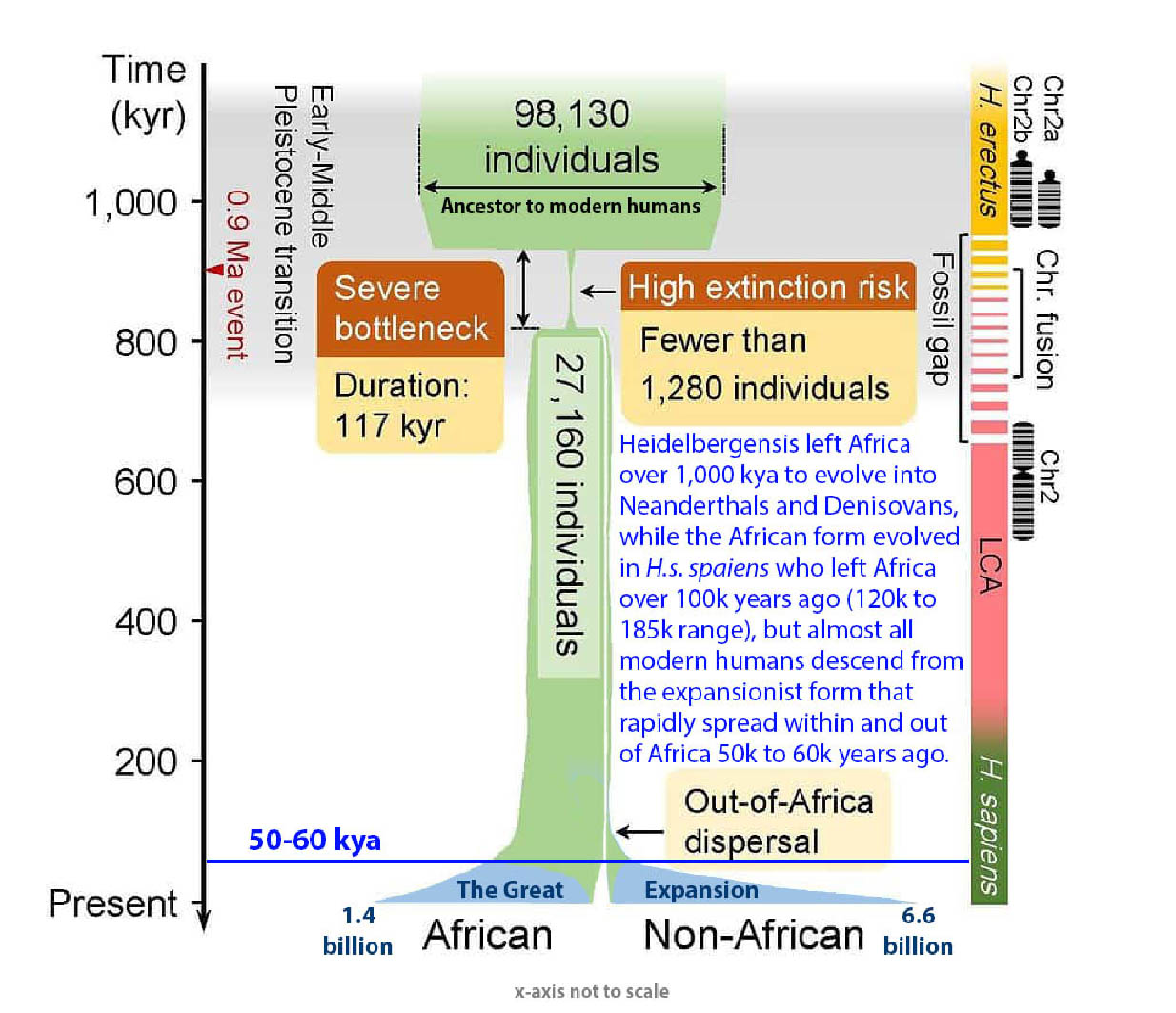
SUNDAY, DEC 22, 2024: NOTE TO FILE

Hominina Species
The taxonomic sub-tribe of humans — know then thy ancestors
Eric Lee, A-SOCIATED PRESS
TOPICS: ALTERNATIVE REASON , FROM THE WIRES, SELECTED EVIDENCE
Abstract: Humans are not just members of our variant of a subspecies. All members of the sub-tribe Hominina were humans with minor distinctions (Neanderthal had bigger brains). Know thy ancestors to know thyself.
COOS BAY (A-P) — Homininans are species (and subspecies) of humans that evolved after diverging from a common ancestor with chimpanzees (Panina) as facultative bipeds 6–7 million years ago to become mostly post-toddler obligate bipeds, aka humans.
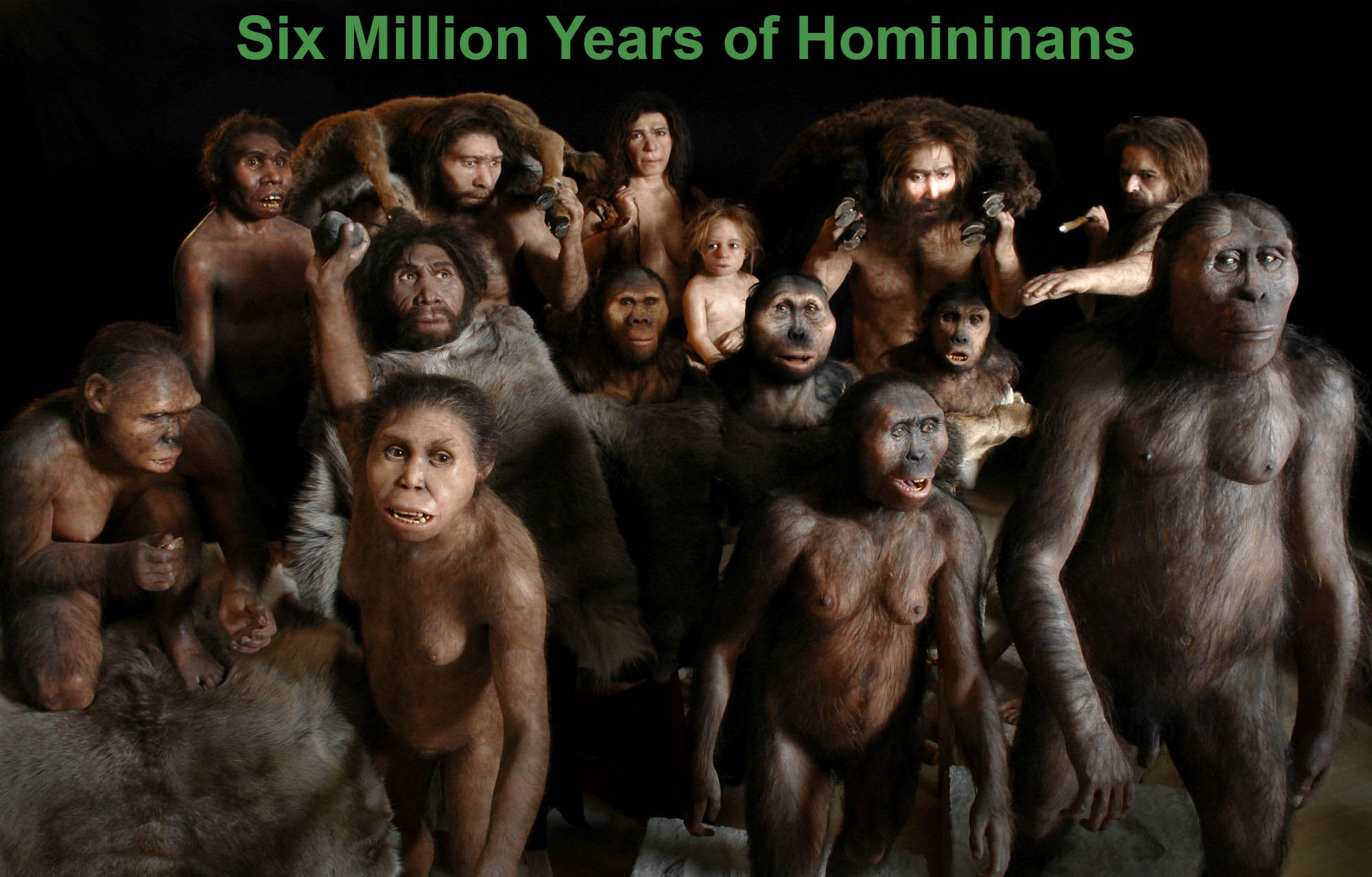
40 generations of technology/ideology domesticants have lived during the global expansion of modern metastatic techno-industrial monetary culture. 3,000 generations of r-selected expansionist humans have lived during the Great Human Expansion. 244,000 generations of K-selected Homininans have lived on Earth so far. How many generations of each form will persist into the future?
1. Homo sapiens
Homo sapiens evolved from the East African subspecies of Homo erectus, H. erectus ergaster (once considered a species, Homo ergaster), about 1.3 million years ago per archaeogenetic reckoning. The species was once called Homo heidelbergensis, then misnamed as a subspecies, Homo sapiens heidelbergensis. Heidelberg Man, however, came after H. e. ergaster, and so is Homo sapiens from whom five subspecies evolved: two within Africa and three after H. sapiens went out of Africa over 1 million years ago.
1a. Homo sapiens neanderthalensis
Homo sapiens neanderthalensis (initially misidentified as a separate species) lived in Europe and parts of western Asia between 800,000 and 40,000 years ago (when H. s. s. var. narrator completed its rapid taking of European megafauna). They had a robust build, a larger brain than us moderns, and were adept at using tools and controlling fire. Some maternal neanderthalensis DNA persists as part of H. s. s. var. narrator DNA of those descended from Man the Hunter expansionists in Europe.
1b. Homo sapiens denisova
H. s. denisova arose from the mid-Asian H. sapiens population about 765k years ago. During the rapid expansion out of Africa beginning about 55k years ago, some Denisovan maternal DNA was added to H. s. s. var. narrator’s DNA.
1c. Homo sapiens sapiens
H. sapiens sapiens is the only surviving species of the genus Homo who originated from the East African population of Homo sapiens about 350k–400k years ago. H. sapiens sapiens in turn left Africa over 100k years ago (120k to 185k range) to join other Homininans (e.g. Homo sapiens [aka H. s. heidelbergensis], H. sapiens neanderthalensis, H. s. denisova) who had left Africa before them (e.g. Homo erectus and subspecies). These early peoples were not conspicuously associated with megafauna extinctions nor the extinction of other Homininans, e.g. Neanderthals, Denisovans, East China and West African subspecies, and populations of Homo erectus such as on Flores that lived in competitive coexistence, persisting where each was favored/better adapted, and not by directly exterminating each other. About 75k years ago a variant (H. s. s. var. narrator) arose that rapidly spread within and out of Africa as a usually clothes-wearing apex predator who spread across the entire globe to become the last Homininan standing apart from perhaps 10k H. s. sapiens San and Hadza.
1d. Homo sapiens juluensis
H. s. juluensis [currently viewed as a separate species, not a subspecies] arose within the H. sapiens population in East China about 300k years ago. Some maternal DNA was added to H. s. s. var. narrator’s DNA.
1e. Homo sapiens exspiravit
H. s. exspiravit [no agreed upon subspecies name yet, no fossils, known via archaeogenetic data] arose within the H. sapiens population in West Africa. Some H. s. sapiens interbred with them about 124,000 years ago and some of their maternal DNA was added to H. s. s. var. narrator’s (Yoruba and Mende remnant population of pre-Bantu expansion Niger-Congo language speakers) DNA.
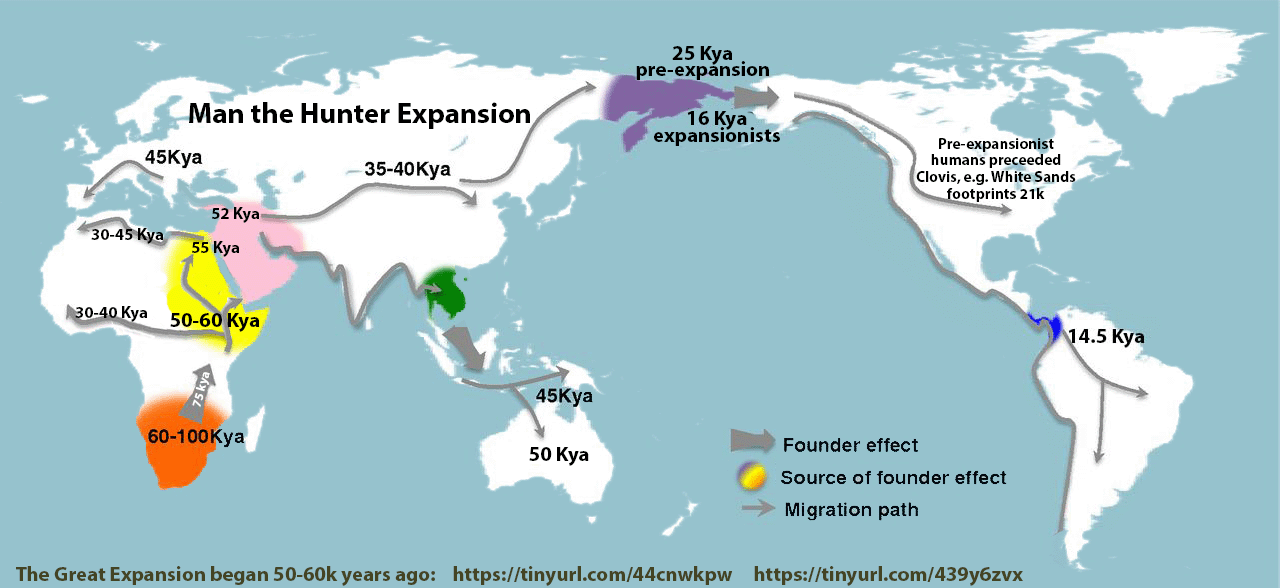
2. Homo longi
Homo longi nicknamed ‘Dragon Man’, from the Northeast China Plain, dating to a minimum 146,000 years ago, known from one skull. Another dubious new species, but may be a new subspecies or variant, e.g. H. sapiens longi or H. s. s. var. longi or just a regional population of Homo sapiens juluensis. Discovering and naming a new species seems to confer higher status/approbation than finding a dubious variant of a subspecies.
3. Homo naledi
Homo naledi was discovered in the Rising Star Cave in South Africa and is believed to have lived between 335,000 and 236,000 years ago. They had a mix of primitive and modern traits, including a small brain but hands and feet adapted for tool use and bipedal walking. Their deliberate burial of the dead suggests advanced social behavior. If Homo sapiens arose from East Africa Homo erectus, Homo naledi arose from the Southern Africa form of Homo erectus.
4. Homo cepranensis
Homo cepranensis from 430k–385k years ago is based on fragments found in Italy. Likely not a separate species or even subspecies. An alternative name would be Homo sapiens var. cepranensis.
5. Homo bodoensis
Homo bodoensis, dating back to 774k years ago, is the proposed alternative name for heidelbergensis if heidelbergensis is defined to not be ancestorial to neanderthalensis. Or heidelbergensis is Homo sapiens, so never mind. Consensus narratives within academia are difficult to change, even by those within academia, which is likely a good thing at times and not at other times.
6. Homo rhodesiensis
Homo rhodesiensis of East Africa, 1.2–0.3 Ma, aka Homo sapiens arcaicus and Homo sapiens rhodesiensis, or regional variations of Homo sapiens prior to or co-existing with H. s. sapiens, i.e. not a species or even subspecies, but Homo sapiens var. rhodesiensis.
7. Homo gautengensis
Homo gautengensis 1.8 million years ago to potentially as late as 600k years ago. Large teeth, more arboreal adapted, perhaps more herbivorous Homo, species distinction disputed. Could be called Homo habilis gautengensis.
8. Homo rudolfensis
Homo rudolfensis of East Africa, 2.5/1.9–1.85/1.55 Ma (million years ago), possibly a species of Australopithecus or subspecies of Homo habilis as the name game is based on too few bone fragments.
9. Homo erectus
Homo erectus lived from about 1.9 million to 110,000 years ago, spreading out of Africa into Eurasia around 1.8 million years ago without associated megafauna extinctions. They were capable of long-distance walking, with an ability to cross open water. They were highly adaptable to different environments due to extensive tool use and being the first species to have control of fire technology that began human domestication/dependency on technology and exosomatic energy, allowing subtropical apes to live in temperate regions.
9a. Homo erectus floresiensis
Homo erectus floresiensis lived on the Indonesian island of Flores about 1 million to 50,000 years ago (when H. s. s. var. narrator passed through in their rapid expansion into Australia whose northern coast may have been inhabited by H. erectus or the pre-expansionist form of H. s. sapiens). They were notably small in stature, with individuals averaging about a meter tall (3.5 feet), leading to the nickname “hobbit.” Despite their small size, H. e. floresiensis made and used stone tools, fire, and hunted small animals like elder brother, as an island dwarf subspecies.
9b. Homo erectus luzonensis
Homo erectus luzonensis (some view as a separate species) was a different island dwarf subspecies living on Luzon 76k–50k years ago who agreed to go live somewhere else when H. s. s. var. narrator passed through and some stayed.
9c. Homo erectus yuanmouensis
H. erectus yuanmouensis inhabited the Yuanmou Basin in Yunnan Province, southwestern China, roughly 1.7 million years ago.
9d. Homo erectus lantianensis
H. erectus lantianensis lived on the on the Loess Plateau in today’s China region 1.65 million to 700k years ago.
9e. Homo erectus nankinensis
H. erectus nankinensis, China subspecies dating to 300k to 620k years old, possible another name for H. e. pekinensis.
9f. Homo erectus pekinensis
H. erectus pekinensis who inhabited the Zhoukoudian cave site in modern northern China.
9g. Homo erectus soloensis
H. erectus soloensis, lived along the Solo River in Java, Indonesia, about 117,000 to 108,000 years ago.
9h. Homo erectus tautavelensis
H. erectus tautavelensis, Tautavel Man, an archaic humans which — from approximately 550,000 to 400,000 years ago — inhabited the Caune de l’Arago, a limestone cave in Tautavel, France. May have been a subspecies of H. sapiens, or H. s. tautavelensis.
9i. Homo erectus palaeojavanicus
H. erectus palaeojavanicus known from part of a skull found in Indonesia, also known as Java Man, from one to 1.8 million years ago, but may be a variant of Homo erectus and not a subspecies.
9j. Homo erectus georgicus
H. erectus georgicus, whose fossils and stone tools recovered at Dmanisi, Georgia, range in age from 1.85 to 1.77 million years old, making the Dmanisi hominins the earliest well-dated hominin fossils in Eurasia and the best preserved fossils of early Homo from a single site.
9k. Homo erectus ergaster
H. erectus ergaster (2.04/1.95–1.4/0.87 Ma), the one who remained in East Africa who did beget H. sapiens.
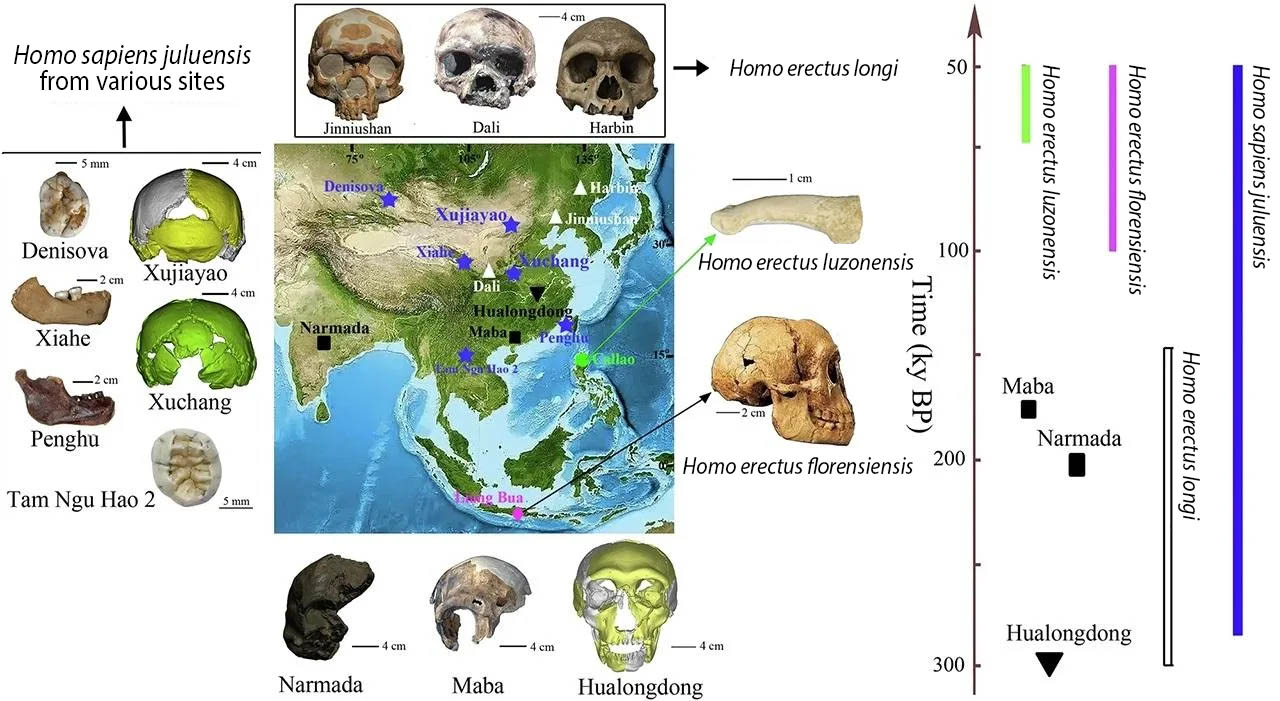
10. Homo antecessor
Homo antecessor (2 to 0.8 Ma), either first Homo or last Australopithecine, ancestor of later Humininans.
11. Homo habilis
Homo habilis evolved in East and South Africa about 2.3 million years ago to 1.65 million years ago was notable for their use of simple stone tools, earning them the name “handy man.” Fossils show that Homo habilis had a relatively larger brain compared to earlier hominins like Australopithecus and was partially tree-dwelling.
12. Paranthropus boisei
Paranthropus/Australopithecus boisei lived in East Africa around 2.5 to 1.15 million years ago. They are known for their large, robust skulls and powerful jaw muscles, which helped them process tough plant-based diets. Paranthropus boisei had one of the largest molars among hominins, indicating a specialized diet. A tree-dwelling species, mobility was limited. Footprints in mud from 1.5 million years ago indicate sympatric coexistence with Homo erectus. Homo sapiens sapiens var. narrator, the last Hominina standing, has failed to coexist with any remaining Homininan, e.g. the remnant population of H. s. sapiens.
13. Paranthropus robustus
Paranthropus/Australopithecus robustus, robust australopithecine, from South Africa region, about 2.27 to 0.87 (or, more conservatively, 2 to 1) million years ago. Like other species of Paranthropus, they had a robust cranial structure and strong chewing muscles, adapted for a diet consisting mainly of tough vegetation. Males had more heavily built skulls than females. The species is thought to have exhibited marked sexual dimorphism, with males substantially larger and more robust than females. Their remains are often found in the same regions as early Homo species, suggesting they lived alongside them. Partially tree-dwelling.
14. Australopithecus afarensis
Australopithecus afarensis lived from about 3.9–2.9 million years ago (mya) was probably a generalist omnivore that inhabited a wide range of habitats with no real preference. May have been ancestor to Homo.
15. Australopithecus prometheus or africanus
Australopithecus africanus lived in Southern Africa around 3.3 and 2.1 million years ago. They are one of the earlier hominin species, with both apelike and humanlike characteristics, including bipedalism and a relatively larger brain. Australopithecus africanus is believed to be a potential ancestor of the Homo genus. Appears to have been patrifocal, with females more likely to leave the group than males. May have been ancestor to Homo.
16. Australopithecus deyiremeda
Australopithecus deyiremeda lived in Ethiopia region about 3.5 to 3.3 million years ago. May have been a subspecies of A. afarensis.
17. Australopithecus anamensis
Australopithecus anamensis lived approximately between 4.3 and 3.8 million years ago in the regions of Kenya and Ethiopia. Ancestor of A. afarensis.
18. Australopithecus bahrelghazali
Australopithecus bahrelghazali found in the region of Chad, lived around 3.5 million years ago, the first and only australopithecine known from Central Africa.
19. Australopithecus garhi
Australopithecus garhi from region of Ethiopia 2.6–2.5 million years ago. A. garhi is the first pre-Homo hominin postulated to have manufactured tools — using them in butchering — and may be counted among a growing body of evidence for pre-Homo stone tool industries (the ability to manufacture tools was previously believed to have separated Homo from predecessors.)
20. Australopithecus sediba
Australopithecus sediba, known from one partial skeleton from South Africa dating to about 1.98 million years ago. A. sediba seems to have eaten only C3 forest plants such as some grasses and sedges, fruits, leaves, and bark. This strongly contrasts from other early hominins which ate a mix of C3 and abundant C4 savanna plants, but is similar to modern savanna chimpanzees. No other hominin bears evidence of eating bark.
21. Ardipithecus ramidus
Ardipithecus ramidus, dated 4.4 Ma. Like most hominids, but unlike all previously recognized hominins, it had a grasping hallux or big toe adapted for locomotion in the trees. Ardipithecus was mainly a terrestrial quadruped collecting a large portion of its food on the ground. Its arboreal behaviors would have been limited and suspension from branches solely from the upper limbs rare. A comparative study in 2013 on carbon and oxygen stable isotopes within modern and fossil tooth enamel revealed that Ardipithecus fed both arboreally (on trees) and on the ground in a more open habitat, unlike chimpanzees.
22. Ardipithecus kadabba
Ardipithecus kadabba, dated to approximately 5.6 million years ago. Likely ancestor of Ar. ramidus.
23. Orrorin tugenensis
Orrorin tugenensis evolved full bipedality 6.1–4.5 Ma found in the region of Kenya. Orrorin had small teeth relative to its body size. Its dentition differs from that found in Australopithecus in that its cheek teeth are smaller and less elongated mesiodistally and from Ardipithecus in that its enamel is thicker. The dentition differs from both these species in the presence of a mesial groove on the upper canines. The canines are ape-like but reduced, like those found in Miocene apes and female chimpanzees. Orrorin had small post-canines and was microdont, like modern humans, whereas australopithecines were megadont.
24. Orrorin praegens
Orrorin praegens means “group of people who came before”. Orrorin is both earlier, by almost 3 million years, and more similar to modern humans than is A. afarensis. But the main Orrorin fossil was probably male and Lucy, the most complete A. afraensis fossil, was female. Orrorin lived in a dry evergreen forest environment, not the savanna assumed by many theories of human evolution. Who else lived in the 3 million year gap may remain to be found.
Sahelanthropus tchadensis
Sahelanthropus, dated to about 7 million years ago, was until recently thought to be the first bipedal ape, hence the first Hominina, but if members of the sub-tribe Panina are facultative bidpeds (knuckle-walkers) and those of Hominina are fully bipedal, then Sahelanthropus would need to be fully bipedal, as was guessed. But a recent femur bone tells a tale of Sahelanthropus being a facultative biped like chimps, so it would want to be classed with its brothers, the Panina. This then makes Orrorin the first Homininan. If Sahelanthropus is ancestral to us, it would share the same last common ancestor we share with the chimps from about 8 million years ago.
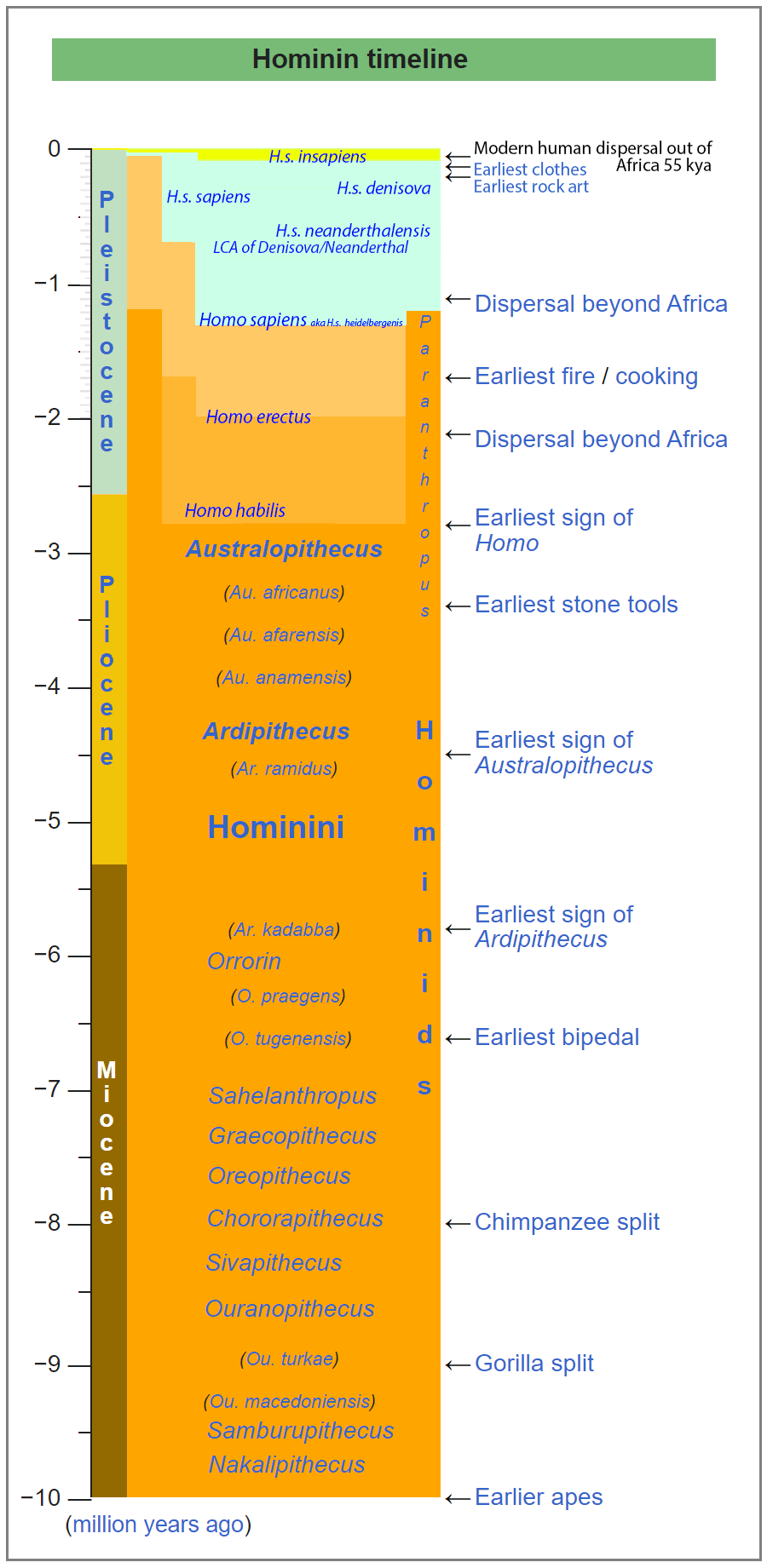
Human ancestors on the Red List
